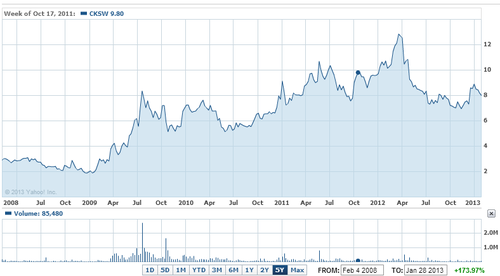 This is the story of a veteran software development company and their adoption of the cloud. This research is presented in two parts.
This is the story of a veteran software development company and their adoption of the cloud. This research is presented in two parts.
The first part is based on an interview with Mr. Igal Korach, Director of Cloud Services at ClickSoftware. It describes the company’s cloud adoption from the perspective of deployment and operations including processes and tools.
The second part of this research below, is based on a conversation with Mr. Udi Keidar, VP of Cloud Services at ClickSoftware. In this post, I will present some interesting business views of a company that, for years, has been successfully delivering its software to the billion dollar enterprise market. I will discuss the disruptive changes this innovative software company experienced regarding sales methodologies, delivery, pricing, and the future direction of their business.
Cloud Supports Mid-market Delivery
The common standard (and I’m still not convinced that there is a standard) of a new B2B SaaS vendor’s sales practice begins with provisioning the online service in a no-touch (or low touch) mode to the SMB. The SMB sales cycle is shorter as a result of quick decision making and procurement processes for small organizations. The next “standard” step for a new SaaS vendor is to reach out to the enterprise market using outbound enterprise sales methodologies. The SaaS market fast development made ClickSoftware dragged into the cloud demand and actually found a great new value for its business.
ClickSoftware has been a market leader for the past decade (as illustrated by the Gartner Magic Quadrant for Field Service Management). Over the years the veteran company has built a successful sales and delivery method for billion dollar enterprises. Among its customers, you can find great companies including DirectTV, Deutsche Telekom, National Grid, Philips Healthcare and more.
One of the important factors that positions ClickSoftware as a market leader is its ability to effectively and consistently deliver a complex BI solution to its enterprise customers. The company always wanted to conquer the SMB markets where the volume of business is huge, hence a tremendous business opportunity. The company did not succeed as expected, however, to deliver to the SMB who found the offerings delivery costs unappealing. The capital expense included building the infrastructure and a long “enterprise” implementation process that was detrimental to the project’s success. Additionally, the ISV leaders figured out that the sales and implementation efforts and investments were the same as for a huge enterprise while the potential revenues and profits were not.
Initially, the cloud was perceived by the company leaders as an evolution. They quickly realized, however, the great potential in having a cloud solution to overcome the mid-market challenge. The cloud values, such as cost, agility and fast delivery, enabled an efficient sales and customer on-boarding processes. In order to achieve clarity with the new innovative pace, the company established a spin-off from its suite, a new on-demand solution called “ClickExpress”. ClickExpress is a pre-packaged offering of relevant features that generates an out-of-the-box service, aimed to fulfill the needs of a growing SME organization.
The New Cloud Customer
Cloud is, first and foremost, a business model. It opens new markets and generates a great new opportunity for traditional ISVs. Companies moving to the cloud will find that they need to refresh and reset their knowledge with regards to their users’ behavior and review or even redefine their target market.
“You need to use cloud smartly. You can’t take an on-premise machine, migrate it to the cloud and say that you run on the cloud. From what I have heard and learnt from IT vendors, as well as consumers, is that they still don’t really understand that concept. Companies that put their on-premise box on the cloud as is, I believe that 99% will fail to adopt the cloud.”
“Your traditional sales discussion changes and the potential customers that ask for a cloud offering can pretty easily find out if you have a real on-demand online service” Keidar noted.
Contrary to the company’s traditional enterprise sales team, Keidar’s cloud team realized that the decision maker is the C-level within their potential SMB cloud customer. This doesn’t mean that the new market is only the mid-market. According to Keidar, the cloud actually enabled bottom-up adoption and as a quick proof of concept for the huge traditional enterprise potential customer.
“We are experienced with potential enterprise customers that ask for fast and agile delivery. As I see it, the big enterprise’s internal organization that needs our application might behave the same as a ‘midmarket organization’ and will fit our cloud offering. Now, we actually have a solution for the great enterprises that have small or medium service workforces. Now we can put ourselves inside the organization very quickly.”
A Startup inside the Organization
Keidar describes his division as an external P&L organization. The team includes all the facilities and resources that his “startup” needs to create a new business. With this, the cloud team has managed to decrease its dependency on other functions in the company, from remote sales representatives to dedicated marketing resources that support the required online growth, thus extending ClickSoftware exposure within the SMB market.
“We are a start-up within ClickSoftware—the ‘mothership venture capital’.”
An ISV that used to work with the billion dollar enterprise needed to protect its cloud adoption pace from getting blocked by the significant traditional influence driven by the company. According to Keidar, the cloud division leader needs to be able to find the right balance between traditional resources and those that must be built “from scratch” to ensure that the agility and speed the cloud enables is not harmed.
“… Don’t confuse me with your enterprise sales and methodologies. Sometimes you must choose to start from scratch in order to shape the final results to be aligned with the cloud’s fast and agile delivery values,” Keidar emphasized.
Traditional enterprise leadership has the power to force its methodologies and behaviors on its cloud division, however that has the potential to destroy cloud adoption and thus the organization’s innovation.
“We, at ClickSoftware, believe that the cloud is a revolution that is here to stay. In the next few years expect to see more and more portions of our offering and business move to the cloud. We already have customers that have asked to renew their ClickSoftware licenses and move the service to our cloud. Our cloud offering sales pipeline is growing faster than the traditional one.”
Pricing, Revenue and Profit Margins

ClickSoftware’s stock (NASDAQ: CKSW) has grown consistently over the last five years. The company reported its total revenues for 2012 increased 15% over 2011 to $100.00 million. Last year, Keidar and his team established a new pricing model, adjusting the traditional software licensing model to a pay-per-site SaaS model. In response to the question, “does your division have better profit margins with the new model?” Keidar answered:
“The (revenues) recognition model changes. In the traditional model, millions in revenues for the license are recognized immediately. In the cloud, your revenues are recognized on a monthly basis. The cloud ‘high volume low margin’ model requires great patience on our part. The challenge for us is to be able to reach a critical mass and to build low cost operations in order to present similar or improved profitability.”
Over the last few years, ClickSoftware has grown consistently and realized its yearly forecasts. Sometimes, however, it failed to do the same on a quarterly basis. This might be the major factor that generated stock instability within a single year. It is clear that a successful cloud delivery with significant recurring revenues of the overall company revenues will enhance the company’s financial stability and forecast accuracy.

Yahoo FInance
IaaS or PaaS? Amazon Cloud is an Operative Solution
ClickSoftware’s native application is built on Microsoft technologies. Interestingly, the company chooses to deliver its cloud offering utilizing the Amazon cloud. It is known that Amazon cloud is the current cloud “teenager” compared to the “child” clouds in the neighborhood. Leveraging IaaS support, ClickSoftware managed to speed it’s time to market. Although Microsoft Azure would have been the natural starting point, starting with PaaS wasn’t an appealing option due to the great migration efforts that would require support from R&D.
“Amazon cloud, among all its values, is also an operative solution. As a market leader we must uphold our reputation. The outsource vendors we hire and the tools and cloud platform we build must provide the carrier-solution grade in operative terms, and Amazon delivers. With Amazon, we can quickly build new features such as backup automation and Disaster Recovery (DRP). We can also deploy detailed cloud monitoring and usage analytic tools such as Newvem to analyze and monitor our cloud SLA and cost. I assume that in the future other cloud operators will support these advanced capabilities, but currently they do not.”
Keidar finds that Amazon is the only option currently available that supports cost optimization utilizing cloud elasticity, security, and compliance standards. Moreover, his team provides ClickSoftware’s traditional customers with an optional DR site on the Amazon cloud, so in a reasonably short period of time their system can run on its “Amazon cloud spare wheel.”
Final Words
Keidar describes the scale as a new challenge. A free trial and funnel management is in development. It was interesting to find that Keidar and his team understand the eco-system values and are currently in an advanced stage of integration with other SaaS vendors to extend their presence. ClickSoftware invested in exposing its API to its customers, enabling them to develop small apps and integrate with their own systems. Keidar sees that as an important features that can extend the on-demand offering.
ClickSoftware’s leadership understands that the cloud is here to stay and it seems that the cloud team gets the support and the independence it needs in order to evolve quickly and effectively.
“ClickSoftware faces great challenges hence great opportunities. The company has many new goals, such as spreading globally to new countries and markets while adopting new technologies and methodologies. In 2013, ClickSoftware is going to further invest in several domains such as the Platform and Mobility. These will definitely strengthen our cloud offerings and position the company as an online SaaS vendor.”
The cloud creates great opportunities for ClickSoftware but it also increases the competition with small startups that see workforce management as a problem that can be solved and delivered as an online SaaS application.
pics credits:





